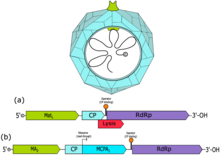| Fiersviridae | |
|---|---|
 | |
| Fiersviridae virion and genomes of (a) bacteriophage MS2 and (b) bacteriophage Qβ | |
| Virus classification | |
| (unranked): | Virus |
| Realm: | Riboviria |
| Kingdom: | Orthornavirae |
| Phylum: | Lenarviricota |
| Class: | Leviviricetes |
| Order: | Norzivirales |
| Family: | Fiersviridae |
| Genera | |
Fiersviridae is a family of positive-strand RNA viruses which infect prokaryotes. [1] Bacteria serve as the natural host. [2] They are small viruses with linear, positive-sense, single-stranded RNA genomes that encode four proteins. All phages of this family require bacterial pili to attach to and infect cells. [3] The family has 185 genera, [4] most discovered by metagenomics. [2] In 2020, the family was renamed from Leviviridae to its current name. [2] [5]
